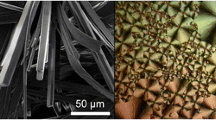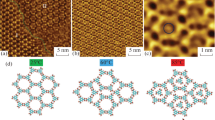Abstract
Two-dimensional self-assembly of melem at pH-controlled aqueous solution-Au(111) interfaces has been investigated by electrochemical scanning tunneling microscopy. In the solutions with pH>pK b1 of melem, two ordered self-assembled structures (honeycomb and close-packed structures) and one disordered fibrillar structure were observed as a function of the surface coverage of melem controlled by the electrode potential. In contrast, in the acidic solution with pH<pK b1 of melem, only the self-assembled honeycomb network was observed in a relatively wide potential range probably due to the presence of monoprotonated melem cations. Dots attributed to counteranions were frequently observed in the pores of the honeycomb network. The lack of close-packed and fibrillar structures at low pH (<pK b1) is attributed to ionic repulsion of melemium cations.

Similar content being viewed by others
References
Mali K S, De Feyter S. Principles of molecular assemblies leading to molecular nanostructures. Philosophical Transactions of the Royal Society of London. Series A, Mathematical and Physical Sciences, 2013, 371(2000): 20120304
Elemans J A A W, Lei S, De Feyter S. Molecular and supramolecular networks on surfaces: From two-dimensional crystal engineering to reactivity. Angewandte Chemie International Edition, 2009, 48(40): 7298–7332
Kudernac T, Lei S, Elemans J A A W, De Feyter S. Twodimensional supramolecular self-assembly: Nanoporous networks on surfaces. Chemical Society Reviews, 2009, 38(2): 402–421
Kunitake M, Higuchi R, Tanoue R, Uemura S. Self-assembled π-conjugated macromolecular architectures—a soft solution process based on Schiff base coupling. Current Opinion in Colloid & Interface Science, 2014, 19(2): 140–154
Zhuang X, Mai Y, Wu D, Zhang F, Feng X. Two-dimensional soft nanomaterials: A fascinating world of materials. Advanced Materials, 2015, 27(3): 403–427
Schwarzer A, Saplinova T, Kroke E. Tri-s-triazines (s-heptazines)—from a “mystery molecule” to industrially relevant carbon nitride materials. Coordination Chemistry Reviews, 2013, 257(13–14): 2032–2062
Wang X, Maeda K, Thomas A, Takanabe K, Xin G, Carlsson J M, Domen K, Antonietti M. A metal-free polymeric photocatalyst for hydrogen production from water under visible light. Nature Materials, 2009, 8(1): 76–80
Franklin E C. The ammono carbonic acids. Journal of the American Chemical Society, 1922, 44(3): 486–509
Finkel’shtein A I, Spiridonova N V. Chemical properties and molecular structure of derivatives of sym-heptazine [1,3,4,6,7,9,9b-heptaaza-phenalene, tri-1,3,5-triazine]. Russian Chemical Reviews, 1964, 33(7): 400–405
Takimoto M, Yokoyama T, Sawada M, Yamashita M. Isolation of melam and melem from fused products of dicyandiamide and melamine and some of their properties. Kogyo Kagaku Zasshi, 1963, 66(6): 793–797
Komatsu T. The first synthesis and characterization of cyameluric high polymers. Macromolecular Chemistry and Physics, 2001, 202 (1): 19–25
Jürgens B, Irran E, Senker J, Kroll P, Müller H, Schnick W. Melem (2,5,8-triamino-tri-s-triazine), an important intermediate during condensation of melamine rings to graphitic carbon nitride: Synthesis, structure determination by X-ray powder diffractometry, solid-state NMR, and theoretical studies. Journal of the American Chemical Society, 2003, 125(34): 10288–10300
Miller D R, Swenson D C, Gillan E G. Synthesis and structure of 2,5,8-triazido-s-heptazine: An energetic and luminescent precursor to nitrogen-rich carbon nitrides. Journal of the American Chemical Society, 2004, 126(17): 5372–5373
Schwarzer A, Böhme U, Kroke E. Use of melem as a nucleophilic reagent to form the triphthalimide C6N7(phthal)3—new targets and prospects. Chemistry, 2012, 18(38): 12052–12058
Uemura S, Aono M, Komatsu T, Kunitake M. Two-dimensional self-assembled structures of melamine and melem at the aqueous solution-Au(111) interface. Langmuir, 2011, 27(4): 1336–1340
Eichhorn J, Schlögl S, Lotsch B V, Schnick W, Heckl W M, Lackinger M. Self-assembly of melem on Ag(111)—emergence of porous structures based on amino-heptazine hydrogen bonds. CrystEngComm, 13(11): 5559–5565
Uemura S, Aono M, Sakata K, Komatsu T, Kunitake M. Thermodynamic control of 2D bicomponent porous networks of melamine and melem: Diverse hydrogen-bonded networks. Journal of Physical Chemistry C, 2013, 117(47): 24815–24821
Yoshimoto S, Itaya K. Adsorption and assembly of ions and organic molecules at electrochemical interfaces: Nanoscale aspects. Annual Review of Analytical Chemistry, 2013, 6(1): 213–235
Uemura S, Tanoue R, Yilmaz N, Ohira A, Kunitake M. Molecular dynamics in two-dimensional supramolecular systems observed by STM. Materials, 2010, 3(8): 4252–4276
Phan T H, Breuer S, Hahn U, Pham D T, Torres T, Wandelt K. Unusual demetalation and ordered adsorption of a pyridineappended zinc phthalocyanine at metal-electrolyte interfaces studied by in situ scanning tunneling microscopy and X-ray photoelectron spectroscopy. Journal of Physical Chemistry C, 2014, 118(1): 457–467
Ye T, He Y, Borguet E. Adsorption and electrochemical activity: An in situ electrochemical scanning tunneling microscopy study of electrode reactions and potential-induced adsorption of porphyrins. Journal of Physical Chemistry B, 2006, 110(12): 6141–6147
Dai P X, Chen T, Wang D, Wan L J. Potential dependent adsorption geometry of 2,5-dihydroxybenzoic acid on a Au(111) Surface: An in situ electrochemical scanning tunneling microscopy study. Journal of Physical Chemistry C, 2012, 116(10): 6208–6214
Yuan Q H, Xing Y, Borguet E. An STM study of the pH dependent redox activity of a two-dimensional hydrogen bonding porphyrin network at an electrochemical interface. Journal of the American Chemical Society, 2010, 132(14): 5054–5060
Sattler A, Schnick W. Preparation and structure of melemium melem perchlorate HC6N7(NH2)3ClO4·C6N7(NH2)3. Zeitschrift fur Anorganische und Allgemeine Chemie, 2008, 634(3): 457–460
Sattler A, Seyfarth L, Senker J, Schnick W. Syntheses, crystal structures and spectroscopic properties of the melem adduct C6N7(NH2)3·H3PO4 and the melemium salts (H2C6N7(NH2)3) SO4·2H2O and (HC6N7(NH2)3)ClO4·H2O. Zeitschrift fur Anorganische und Allgemeine Chemie, 2005, 631(13–14): 2545–2554
In our investigation, melem is dissolved into 0.1 mol·L-1 perchloric acid solution (pH = 1.3) at least around 6 × 10-5 mol·L-1
Li Z, Han B, Wan L J, Wandlowski T. Supramolecular nanostructures of 1,3,5-benzene-tricarboxylic acid at electrified Au(111)/0.05 mol·L-1 H2SO4 interfaces: An in situ scanning tunneling microscopy study. Langmuir, 2005, 21(15): 6915–6928
Zhang HM, Xie Z X, Long L S, Zhong H P, Zhao W, Mao BW, Xu X, Zheng L S. One-step preparation of large-scale self-assembled monolayers of cyanuric acid and melamine supramolecular species on Au(111) surfaces. Journal of Physical Chemistry C, 2008, 112 (11): 4209–4218
Ivasenko O, Macleod J M, Chernichenko K Y, Balenkova E S, Shpanchenko R V, Nenajdenko V G, Rosei F, Perepichka D F. Supramolecular assembly of heterocirculenes in 2D and 3D. Chemical Communications, 2009, 10: 1192–1194
Griessl S J H, Lackinger M, Jamitzky F, Markert T, Hietschold M, Heckl W. Room-temperature scanning tunneling microscopy manipulation of single C60 molecules at the liquid-solid interface: Playing nanosoccer. Journal of Physical Chemistry B, 2004, 108 (31): 11556–11560
Cardenas M L, Lipton-Duffin J, Rosei F. Transformations of molecular frameworks by host-guest response: Novel routes toward two-dimensional self-assembly at the solid-liquid interface. Japanese Journal of Applied Physics, 2011, 50(8S3): 08LA02
Ma X, Yang Y, Deng K, Zeng Q, Zhao K, Wang C, Bai C. Molecular miscibility characteristics of self-assembled 2D molecular architectures. Journal of Materials Chemistry, 2008, 18(18): 2074–2081
Wang H, Kaiser T E, Uemura S, Würthner F. Perylene bisimide J-aggregates with absorption maxima in the NIR. Chemical Communications, 2008, 10: 1181–1183
Samorí P, Severin N, Simpson C D, Müllen K, Rabe J P. Epitaxial composite layers of electron donors and acceptors from very large polycyclic aromatic hydrocarbons. Journal of the American Chemical Society, 2002, 124(32): 9454–9457
Uemura S, Sakata M, Taniguchi I, Hirayama C, Kunitake M. In situ observation of coronene epitaxial adlayers on Au(111) surfaces prepared by the transfer of Langmuir films. Thin Solid Films, 2002, 409(2): 206–210
Elemans J A A W, Lensen M C, Gerritsen J W, van Kempen H, Speller S, Nolte R J M, Rowan A E. Scanning probe studies of porphyrin assemblies and their supramolecular manipulation at a solid-liquid interface. Advanced Materials, 2003, 15(24): 2070–2073
Sek S, Xu S, Chen M, Szymanski G, Lipkowski J. Molecular resolution imaging of an antibiotic peptide in a lipid matrix. Journal of the American Chemical Society, 2008, 130(17): 5736–5743
Gutzler R, Sirtl T, Dienstmaier J F, Mahata K, Heckl W M, Schmittel M, Lackinger M. Reversible phase transitions in self-assembled monolayers at the liquid-solid interface: Temperature-controlled opening and closing of nanopores. Journal of the American Chemical Society, 2010, 132(14): 5084–5090
Author information
Authors and Affiliations
Corresponding authors
Rights and permissions
About this article
Cite this article
Uemura, S., Sakata, K., Aono, M. et al. Two-dimensional self-assembly of melem and melemium cations at pH-controlled aqueous solution–Au(111) interfaces under electrochemical control. Front. Chem. Sci. Eng. 10, 294–300 (2016). https://doi.org/10.1007/s11705-016-1564-4
Received:
Accepted:
Published:
Issue Date:
DOI: https://doi.org/10.1007/s11705-016-1564-4




